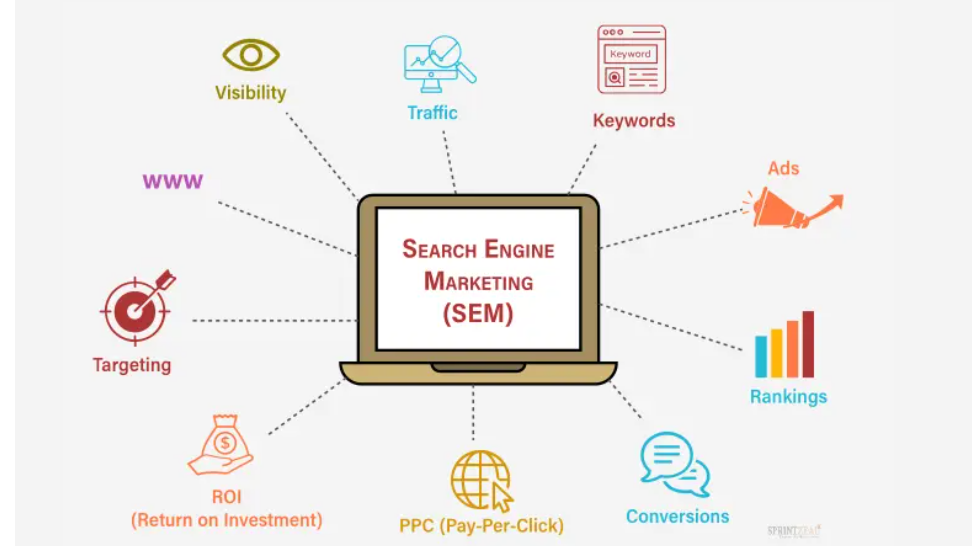
Search Engine Marketing (SEM) is an effective strategy that businesses use to enhance their online visibility and drive targeted traffic through paid search ads. Whether you're just starting with SEM or looking to improve your existing campaigns, this guide offers a detailed overview of what SEM is, its benefits, and practical strategies to boost your visibility in search engine results pages (SERPs).
What Is Search Engine Marketing?
Search Engine Marketing (SEM) is the practice of using paid advertisements that show up on search engine results pages (SERPs). Advertisers bid on keywords that potential customers might use when searching for specific products or services, allowing their ads to appear alongside the search results. SEM is an essential component of digital marketing strategies because it lets businesses directly target users based on their search intent, which can result in more traffic, better conversions, and improved visibility.
The Difference Between SEO and SEM
Many people confuse Search Engine Optimization (SEO) and SEM, but they are two different techniques. SEO focuses on improving your website's organic visibility by optimizing its content, keywords, and backlinks. SEM, on the other hand, involves paying for ads to show up at the top or bottom of search engine results pages. SEM offers instant visibility, while SEO is a longer-term approach that builds ranking over time.
Why Is SEM Important for Businesses?
Search Engine Marketing is vital for businesses that want to enhance their online presence and attract relevant traffic to their websites. Below are a few key reasons why SEM is critical for success:
- Immediate Visibility: Unlike SEO, which takes time to rank organically, SEM allows businesses to instantly appear at the top of search results.
- Targeted Traffic: With SEM, businesses can target specific keywords, ensuring their ads reach users actively searching for their products or services.
- Measurable ROI: SEM platforms, such as Google Ads, offer robust analytics to track campaign performance, allowing businesses to refine their strategy for maximum return on investment (ROI).
How Does Search Engine Marketing Work?
SEM works on a pay-per-click (PPC) model, where advertisers pay for each click on their ad. Here’s a breakdown of how SEM functions in three simple steps:
- Keyword Research: The first step is to find the right keywords that your target audience uses. Tools like Google’s Keyword Planner or SEMrush can help discover keywords with high search volumes and lower competition.
- Ad Auction: When users perform a search, an auction takes place to determine which ads will show. Google evaluates factors such as bid amount and ad relevance to select the best ad placement.
- Paid Ad Display: The winning ad is displayed in the search results, and businesses are charged when users click on the ad, leading them to the desired landing page.
Mastering SEM Keyword Research
Successful SEM campaigns rely heavily on thorough keyword research. The keywords you choose lay the groundwork for your SEM efforts, so it’s crucial to find the best ones for your business. Tools like Google Ads Keyword Planner, Moz, and SEMrush are great for identifying high-volume, low-competition keywords.
Here are the three main factors to consider during keyword research:
- Search Volume: Focus on keywords that your target audience frequently searches.
- Keyword Competition: Choose keywords with lower competition to minimize costs and maximize ad exposure.
- Relevance: Ensure the keywords are directly related to your products or services to attract quality leads.
Key Features of a Successful SEM Campaign
To craft a winning SEM campaign, you need to focus on these essential elements:
- Ad Copy & Landing Pages: Your ad copy should grab attention and prompt users to click. Once they click, ensure they land on an optimized page that drives conversions. Keep the page relevant, fast, and easy to navigate.
- Targeting & Budget: Define who you want to reach based on demographics, search behaviors, and location. Set a daily budget that aligns with your marketing goals, and adjust as needed based on performance.
- Campaign Structure: Create ad groups based on related keywords, themes, or products. This structure allows for more relevant ads and higher performance.
- Ad Optimization: Continuously monitor ad performance through analytics provided by Google Ads or Bing Ads. Optimize your bids, keywords, and ad copy based on this data for better results.
Popular SEM Platforms for Paid Search Advertising
While Google Ads is the most well-known SEM platform, other platforms can also be useful, depending on your business needs:
- Google Ads: The largest and most popular SEM platform, perfect for reaching a broad audience on Google’s search network.
- Bing Ads: With a smaller market share, Bing Ads has less competition and often lower costs per click.
- Amazon Advertising: For e-commerce businesses, Amazon offers SEM that allows sellers to promote their products within search results.
- Yahoo Search Ads: Although less popular than Google or Bing, Yahoo offers a lower-cost option for SEM.
Benefits of SEM for Small Businesses
Small businesses can significantly benefit from SEM because it allows them to compete with larger brands without needing massive marketing budgets. Here’s why SEM is perfect for small businesses:
- Flexible Budgeting: SEM platforms let you set daily budgets that fit your goals without needing large upfront investments.
- Local Targeting: You can specifically target local users, making SEM great for businesses serving local markets.
- High ROI: With proper management and constant optimization, SEM can generate a high return on investment.
Frequently Asked Questions About Search Engine Marketing
What is Search Engine Marketing?
SEM is a digital marketing method that uses paid ads to increase website visibility on search engine results pages (SERPs).What is the difference between SEO and SEM?
SEO improves organic rankings, while SEM uses paid ads to enhance search engine visibility.What are the three types of SEM?
The primary types of SEM include paid search ads (PPC), local search ads, and display ads.What is an example of a search engine marketing platform?
Google Ads is the most popular SEM platform, allowing businesses to bid on keywords and run paid campaigns.
Conclusion: Achieving Success with SEM
By learning how SEM works and applying the right strategies, you can significantly improve your business’s online presence. Focus on detailed keyword research, monitor ad performance, and optimize campaigns to drive meaningful results.
For more insights on how Search Engine Marketing works, check out this video on:
By following these strategies, you’ll be able to build a robust SEM campaign that propels your business to new heights in today’s digital landscape.
 Add Row
Add Row  Add
Add 




Write A Comment